By Omar Hassen, Associate Vice President of Connectivity Business, AppliedMicro
As will no doubt be evident at this year’s OFC, the strong demand in 100G Ethernet is being driven by cloud services and hyperscale data centers. Data center customers are demanding a steep downward trajectory in the cost of 100G pluggable transceivers. Existing 100G module MSAs (Multi-Source Agreements) such as PSM4 and CWDM4 have limited capacity for cost reduction due to the cost of the fiber (PSM4) and the large number of components (both PSM4 & CWDM4). Similarly, two-lambda PAM4 (2x50G) trades off some optical components for a more expensive DSP and will struggle to improve upon the cost of CWDM4.
True 100G (single-lambda 100G PAM4) offers the simplest architecture, the most streamlined data path, higher reliability, an easy upgrade path to 400G Ethernet and enables the lowest cost 100G transceiver.
The market transition to 100GE is now in full force, fueled primarily by the seemingly insatiable need for networking bandwidth by hyperscale data centers and cloud services. Ovum reports that by 2021, 100-gigabit-per-second (100G) Ethernet Transceivers will exceed 15 million units a year (Figure 1).
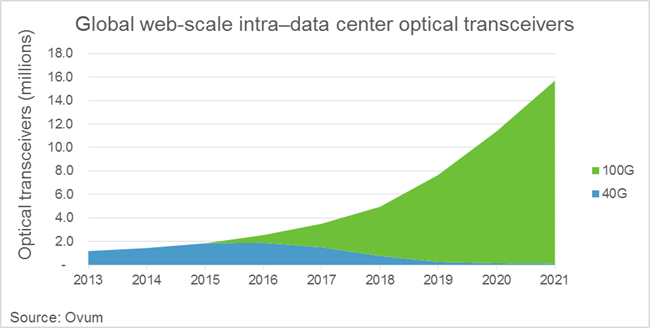
Figure 1: 100G Transceiver Forecast
This tremendous growth in deployments by a small number of key customers coupled with a large number of suppliers competing for these orders will undoubtedly drive down the cost of 100GE modules rapidly. An industry survey of analysts and vendors indicates that the cost of 100GE transceiver is expected to decline by ~75% in the next couple of years. In the meantime, Facebook has publicly set a target cost of $100 for a 100GE transceiver with a reach of less than 2km. While the Facebook target appears to be years away, we believe that a 70% cost reduction in 2 years is possible and that the only way to get there is by changing the optical transceiver architecture to a PAM4 single lambda configuration.
Form Factors and Multisource Agreements (MSAs)
In the past few years, a number of 100GE module form factors and MSAs have emerged. However, the industry has largely aligned behind QSFP28 as the form factor of choice for short 100GE links (< 10Km). Hence, this paper will focus on the QSFP28 form factor.
In the 2km range, PSM4, CLR4 and CWDM4 are battling it out. As CLR4 and CWDM4 are similar enough to be interoperable, the term CWDM4 will be used to cover both types.
Both PSM4 and CWDM4 architectures take the 100GE signal and carry it over 4 separate channels. In the case of CWDM4, different lambdas define the four channels, while in PSM4, distinct fibers define the channels.
Looking back in history about 15 years, the IEEE 802.3ae group defined a number of different PMDs for carrying 10G Ethernet over fiber -SR, -LR, -ER and -LX4 PMDs. While LX4 was the first to be deployed and all the rage at that time, most of the readers are now refreshing their memory by “Googling” LX4. LX4 was a parallel method to carry 10GE over 4 channels running at 2.5G.
Coming back to 100GE. PSM4 uses 8 parallel fibers (4 transmit and 4 receive), each transmitting at 25Gbps (Figure 2). PSM4 is limited to 500m. Its cost structure is driven by the cost of the fiber and the high component count.
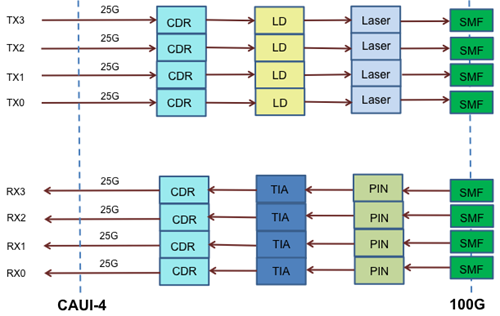
Figure 2: PSM4 Transceiver
CWDM4 (Figure 3) as opposed to PSM4, uses an optical multiplexer and de-multiplexer to reduce the number of fibers to 2. CWDM4’s cost is driven by the high component count.
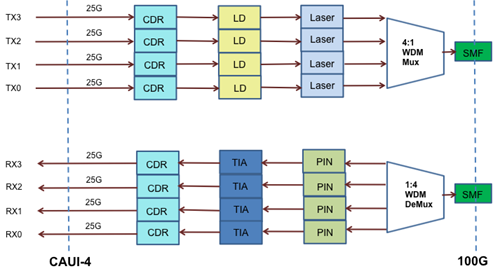
Figure 3: CWDM4 Transceiver
While it would be easy to disagree with the exact position of the different cost curves below (Figure 4), or discuss for hours about the exact time at which maturity might happen, it is easy to understand that the relative position of the cost curves is representative.
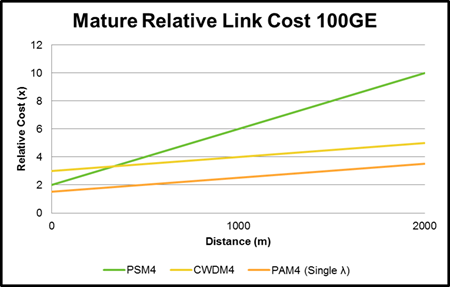
Figure 4: Relative link costs
Avenues For Cost Reduction – Margin Compression
So where will the cost reduction come from?
Given the limited room for feature and performance differentiation among the components in a PSM4 or CWDM4 transceiver and the relative maturity of these components, the cost reduction will come primarily from margin compression along the supply chain. As with any price competition, prices will stabilize as certain suppliers exit the bidding war and the overall transceiver cost will not reduce any further.
Having spoken to a number of suppliers, vendors and industry analysts; we believe that neither PSM4 nor CWDM4 will be able to achieve the 70% cost reduction target via margin compression alone. A fundamental change is required.
The case for PAM4 Single lambda: “True 100G”
PAM4 makes more efficient use of the electronic and optical components by packing 2 bits for every symbol sent over the fiber. This allows for a reduction in the number of expensive components (drivers, lasers and TIAs), but requires the use of a DSP to encode and decode the signal. While the DSP adds cost, compared with a simple quad 25G re-timer employed in PSM4 or CWDM4, the lower component count more than offsets the DSP cost and enables a lower overall module cost.
To implement a 100G Transceiver using PAM4, two options are currently being discussed in the market: 2x50G PAM4 and 1x100G PAM4 (True 100G).
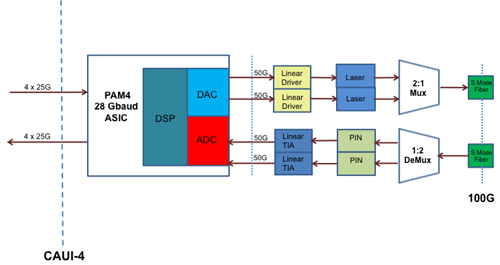
Figure 5: 2x50G PAM4
The 2x50G solution (Figure 5), will share the downside of a parallel architecture as well as requiring a DSP. It will also require an ecosystem to develop around “dual” components, which is currently not well established (Components typically come in “single” or “quad” configurations).
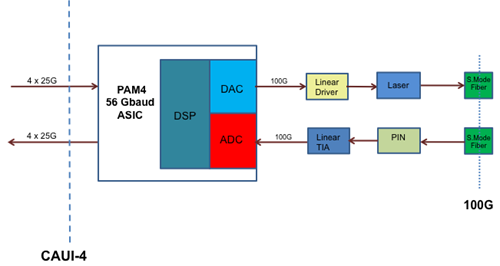
Figure 6:True 100G; Single Lambda 100G
One can immediately see that the single laser solution (Figure 6) offers the optimal component count, the simplest architecture hence the potential to achieve the lowest cost. In addition, reducing the optical components to the minimum required set enhances module reliability, as the optical components have the highest failure rate over time.
So, why is 100G Single Lambda PAM4 not here today?
The QSFP28 form factor limits the power of the entire transceiver to 3.5W. 16nm FinFET is the first technology node that facilitates both the design and operation of power efficient DSPs while leaving enough of the available module power for the rest of the components in the QSFP28. In order for QSFP28 to be built around 100G Single Lambda PAM4, all of the components have to fit into the 3.5W power envelope dictated by the thermal requirements of high density switches & routers.
It is important to mention that the single laser implementation will achieve lower power than the dual laser solution by virtue of having a smaller number of high-speed analog circuits and optical components, which consume a relatively large amount of power in a PAM4 transceiver.
Volume is the primary driver for cost of components once the technology reaches maturity. Therefore, while the dual laser PAM4 architecture (2x50G) currently uses components that appear to cost less, the lack of a “dual” ecosystem and the fact that the single lambda solution continues to be the ultimate goal means that the volume for a 2x50G solution will never truly materialize. Hence it can never achieve the overall cost reductions that only occur with massive deployment and high volumes. At this point, many in the industry have started questioning whether dual laser PAM4 can ever compete against CWDM4.
With its streamlined architecture, lower cost and higher reliability, single laser 100GE PAM4, or “True 100G” can be seen as the equivalent of SFI at 10GE. SFI & SFP+ enabled the cost reduction and high density required to drive the growth of 10GE. We believe in “True 100G”.

|
Omar Hassen is the Associate Vice President of Connectivity Business at AppliedMicro |
Posted: 11 March 2016 by
Omar Hassen, Associate Vice President of Connectivity Business, AppliedMicro
| with 0 comments